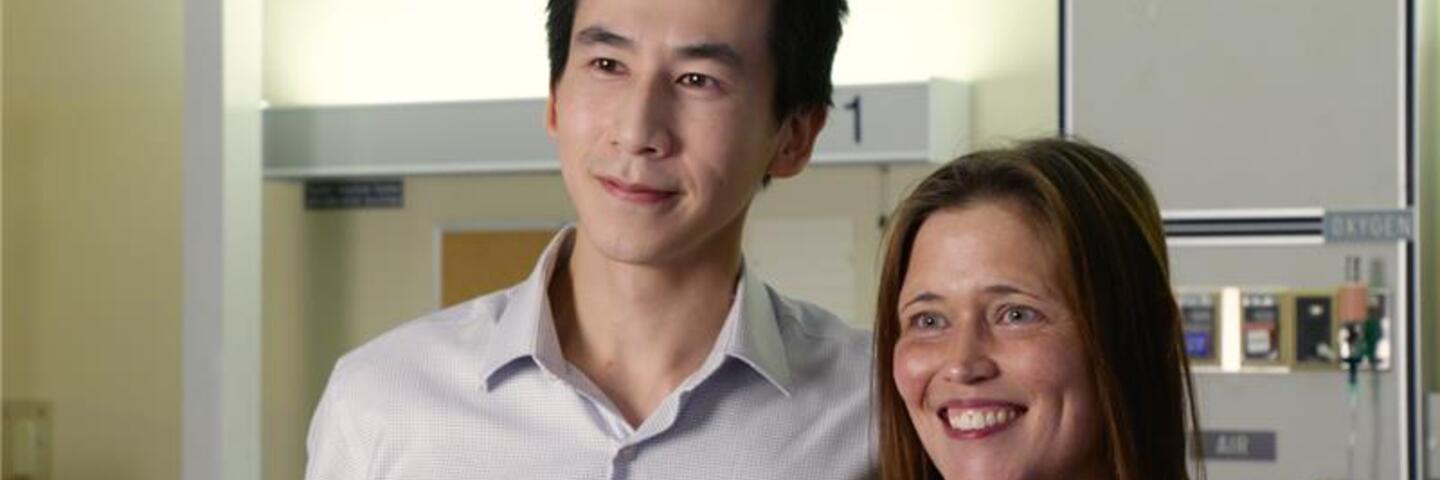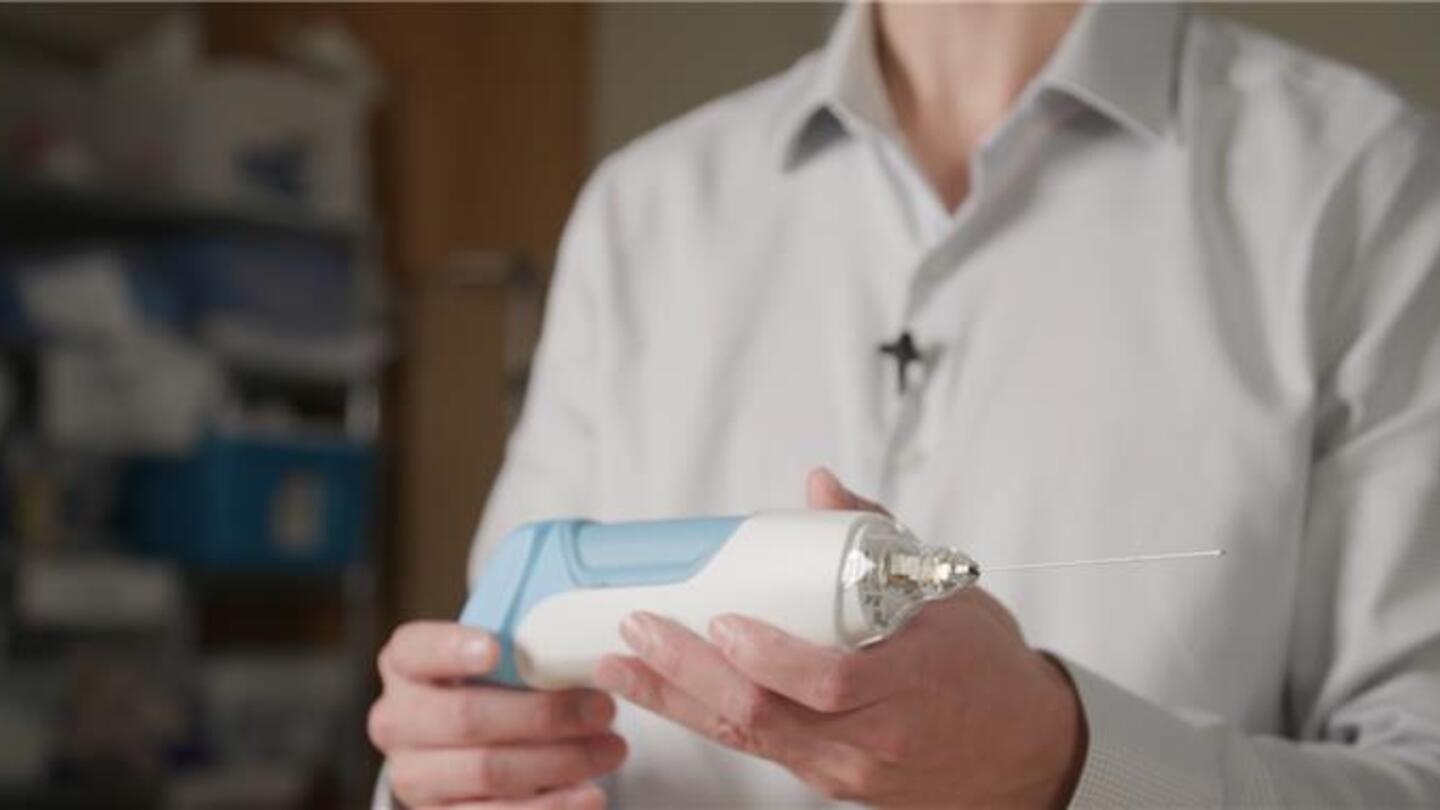Putting Pain on Ice: The Medical Innovation Changing Pain Management
How a cutting-edge technology helped one patient recover faster—with less medication.
Impact Innovation | Innovarium

When Julie Bard learned she needed her ninth cardiac surgery, her first thought wasn't about the procedure itself – it was about the grueling recovery that would follow. Her previous experiences had been marked by intense pain, heavy medication use, and the foggy, nauseating side effects that came with opioid-based pain management.
But this time would be different, thanks to a technology that sounds more like science fiction than modern medicine: controlled nerve freezing.
"I was more alert, sitting up sooner, and didn't feel as much pain," Julie recalls of her recovery, comparing it to her previous surgeries. "I didn't need as much pain medication, and I wasn't getting sick all the time from the side effects."
The game-changing treatment Julie received is called cryoneurolysis, a technique that uses extreme cold to temporarily block nerve signals responsible for transmitting pain. While the concept isn't new – doctors have known about the pain-relieving properties of cold temperatures since the 1970s – recent innovations have transformed this treatment from a cumbersome procedure requiring hospital infrastructure into a portable, bedside solution.

How Freezing Pain Works
Dr. Michael Jew, an anesthesiologist at Providence Health Care in Vancouver who pioneered the hospital's cryoneurolysis program, explains the science behind the treatment: "Through a needle, we target specific nerves and apply super cold temperatures to generate an ice ball around them. This reversibly blocks the nerve conduction, preventing pain signals from reaching your brain for weeks to months."
While cryoneurolysis itself isn't new to pain management, Dr. Jew's application of the technology is groundbreaking. 'Cryoneurolysis is actually a very old interventional pain modality used in chronic pain,' he explains. 'My focus has been on acute pain, which is a relatively novel application that is picking up a lot of attention in the medical community.' The team's preoperative use of cryoneurolysis for acute surgical pain represents some of the first documented cases in medical literature, with promising results.
This precision approach is particularly significant given Canada's ongoing opioid crisis. According to Statistics Canada, in 2018, approximately 3.7 million Canadians (12.7% of those aged 15 and older) reported using opioid pain relievers in the past year. Among them, nearly 351,000 (9.7%) engaged in problematic use. ‘
"Having an option that doesn't use any medication – it's just super cold temperatures – is potentially a means to treat patients for a long time before any exposure to opioids at all," Dr. Jew emphasizes.
“Traditional pain management methods” is a broad term, yes opioids and other pharmacological agents would be included but negates other perioperative treatment options such as regional anesthesia, nerve blocks, infusions and epidurals.

A Game-Changer in Pain Management
For Julie, the difference was dramatic. On day one in the ICU, she was already more alert and engaged than during previous recoveries. Her family noticed the difference immediately. "They were all like, 'whoa,' because they were not used to that," she says. The reduced need for pain medication meant fewer side effects, allowing her to eat sooner and maintain clearer cognition throughout her recovery.
The journey to implementing this technology began with Dr. Jew's observations as an anesthesiologist managing acute pain. “One of my early realizations was that the acute pain trajectory of many types of injuries, particularly to the chest wall such as with rib fractures and surgical incisions, often extend beyond the patients' time in hospital,” he explains. “Our main pharmacological options for pain control are also often limited by undesirable side effects.” This led him to seek out treatment options that could provide long-lasting pain relief with minimal side effects, ultimately landing on cryoneurolysis.
The technology's portability has been revolutionary for hospital care. Previous versions required bulky equipment connected to hospital gas lines or large nitrous oxide canisters. Today's handheld device, about the size of a power drill, can be brought directly to a patient's bedside. Using an ultrasound-guided procedure, physicians can precisely target pain-transmitting nerves and create a small ice ball that blocks pain signals.
The impact extends beyond cardiac surgery. Dr. Jew reports success treating various forms of chest wall trauma, including multiple rib fractures. "Between 50 to 100% of their pain is gone essentially by the time I finish the procedure," he notes. "We've managed to keep patients out of the ICU because they've been able to breathe better and mobilize for the first time in days." This is not only a major win for patients, who experience shorter recoveries with fewer complications, but also a significant cost savings for the health care system, as each day in the ICU costs $8,335 per patient.

A Future with Less Opioid Use?
Supported by the BC Ministry of Health's Innovation Pathway program, the initiative at Providence Health Care is expanding to serve more patients and conditions. Providence is launching studies to examine the treatment's potential in reducing chronic post-surgical pain, among other applications, and accelerating ICU discharge rates.
For Julie, who knows more surgeries lie in her future, the technology represents hope. "I say, go for it," she advises other patients considering the treatment. "It's a little uncomfortable during the procedure, sure, but it's short-term pain for long-term gain."
As health care systems worldwide grapple with pain management and opioid dependency, innovations like portable cryoneurolysis offer a promising path forward. By freezing pain at its source , this technology isn't just changing how we manage post-operative recovery – it's potentially reshaping our entire approach to pain management in the digital age.
The future of pain management might just be ice cold, and that's exactly what patients like Julie are warming up to.